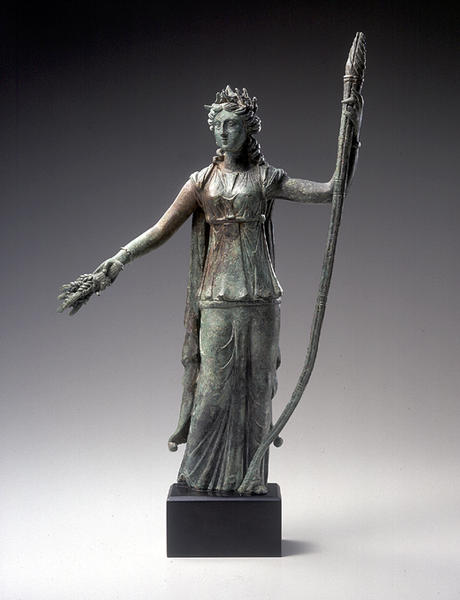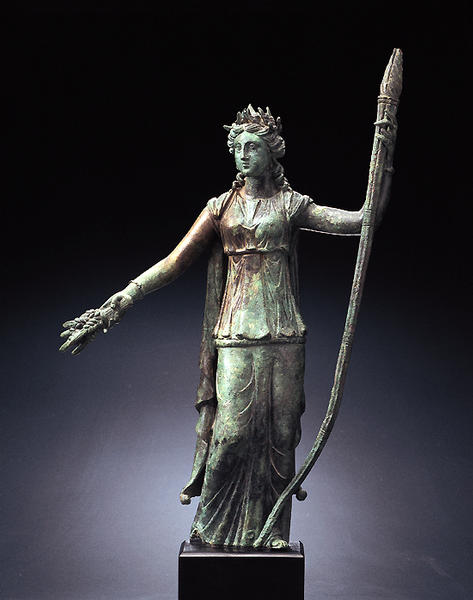ケレース神像
- ローマ
- 1世紀
- 青銅
- H-33.2 D-9 W-25.5
Catalogue Entry
This lovely statuette represents Ceres,1 the Roman goddess of agriculture, who holds a long torch upright with her left hand and in her extended right hand holds a bouquet of wheat stalks. Ceres's name derives from the pre-Indo-European root of the verb ker, "to grow," which refers to her earlier manifestation as an indigenous Italic goddess of cereal grains. From the fifth century B.C. onward, she gradually assumed the guise, mythology and attributes of her Greek counterpart, Demeter, by adopting her corona spicea (crown of wheat stalks, sometimes interspersed with poppy buds) and torch. Just as Demeter used the torch to illuminate the Underworld while she looked for her abducted daughter, Ceres used it in her search for her own daughter, Prosperina, who was likewise kidnapped by a god of the Netherworld.2 By the time bread supplanted cereal as the principal staple of the Roman diet,3 Ceres was goddess of the entire agricultural realm.
The artist who fashioned this statuette paid careful attention to detail. Parted in the middle, Ceres's hair is pulled up at the back and held in place by her corona spicea, except for several long, curly locks which, cast in the round, cascade over her shoulders. Incision was used to shape the curls on her forehead and to separate the locks behind her crown. Ceres's attenuated proportions are emphasized by her garments, a high-girded peplos (short dress), with punched patterns on its border worn over a short-sleeved chiton (long dress) which falls to the ground. A palla (mantle) with weighted corners falls down her back in a series of V-shaped folds. Incised sandal straps are visible on the top of her left foot, and she wears a bracelet on each wrist.
The considerable care taken in the rendering of the goddess, combined with her attributes, sharp features, and a Polykleitan stance, suggest this statuette was made in the first century A.D. Small-scale bronze representations of Ceres are not common, but, like other statuettes of divinities, this figure may have been an object of veneration in a Roman household shrine.
KM
1. LIMC 4 (1988), pp. 893-908, s.v. Ceres (by Stefano de Angeli).
2. Spaeth 1996, the most comprehensive study of the goddess, is the basis for the preceding account.
3. Grant 1975, p. 58.
解説(古代バクトリア遺宝展)
1世紀
青銅
高33.2 cm 幅25.5 cm 奥行9.0 cm
この青銅製の小像は、麦の冠を被り、キトンの上にペプロスを着け、麦の穂の束を右手に持って右前方に差し出し、左手には松明を捧げている。この姿は典型的なローマのケレース女神のものである。生きとし生けるものの成長を司るケレース女神は、元来イタリア土着の最も古い神の一つであり、しばしば麦の穂の束を持ち、麦の冠を頂く姿で表される農耕神でもある。ローマ人は遅くとも前5世紀頃からこの神をギリシャの大地母神デーメーテールと同一視し、その神話と姿を摂取した。そしてデーメーテールが冥界の神ハデスにさらわれた娘ペルセポネをさがす時にかざした松明をケレースにも持たせるようになったが、これは通過儀礼に伴う松明をも象徴している。この儀礼はアウグストゥスを始め多くのローマ皇帝も受けたと言われているが、それはペルセポネの略奪神話を基にした秘儀であり、欲望や残虐性をもった人間を浄化して文化的人間にし、死後の安寧をも獲得する目的のものであったと考えられている。
Catalogue Entry(Bac#037)
1st century A.D.
Bronze
H. 33.2 cm, W. 25.5 cm, Depth 9.0 cm
This small bronze figure wears a crown of wheat, and a peplos over a chiton. She holds a sheaf of grain in her right hand, extended out to the right front, while her left hand holds a torch. This figure depicts the typical iconography of the Roman goddess Ceres. This goddess governed life and growth, and was one of the most ancient gods of the Italian peninsula. Frequently she is shown as the goddess of agriculture with her sheaf of wheat and wheat crown. As late as ca. the 5th century BC, the Romans identified this goddess with the Greek earth mother goddess Demeter, and she took on the attributes of the Demeter myth. Just as Demeter used a torch in her search of the underworld for her daughter Persephone, Ceres is also shown holding a torch. This torch also symbolizes the torches used at rites of passage. These rites were begun by Augustus and then are said to have been carried out by a number of Roman emperors. These rites are said to have been based on the kidnapping of Persephone myth. These rites were said to purify mankind of its covetousness and lingering bestial qualities and make them more civilized humans, while also aiming to assure a peaceful afterlife.

